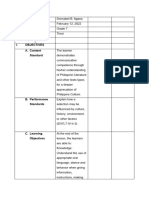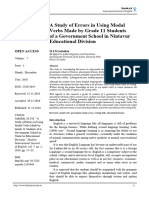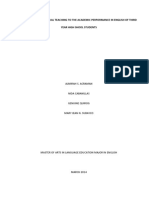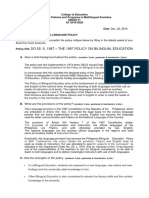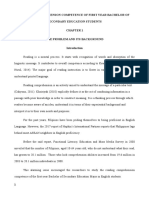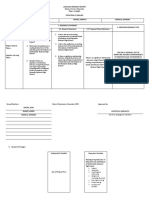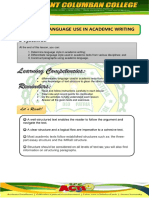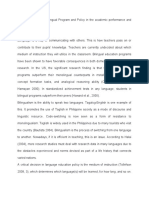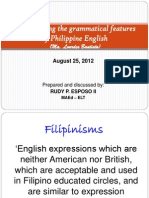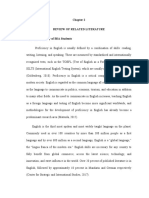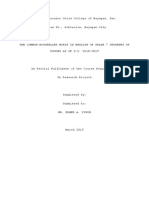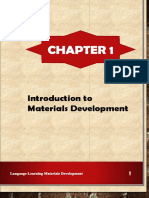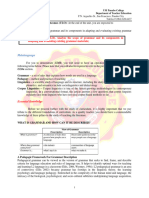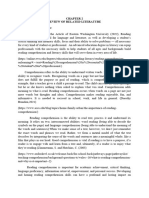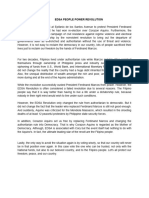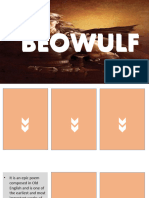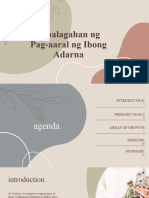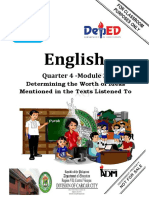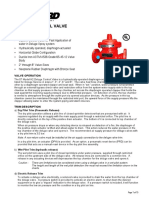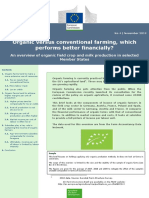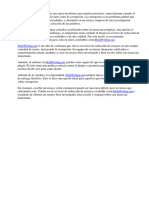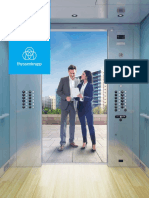The present study deals with the Assessment of English Language Teaching using
Communicative Approach in Distance Learning in Maravilla National Senior High School.
The assessment served as the result of effectivity of the communicative language teaching
approach as employed in Maravilla National Senior High School even in the distance
learning setup and through the modular distance learning approach. This yielded to the
outcomes that the communicative language teaching is focused on learner-centeredness
in the sense that learners are central in terms of teaching and learning processes and
goals. With this, instructional techniques should see to it that learners are involved in the
process of expression, interpretation, and negotiation of meaning through communicative
tasks and activities.
Maravilla National Senior High School students, though some of them preferred to
have the communicative language teaching approach in a face-to-face interaction,
responded positive attitude towards the approach in general. Believing that this learner-
centered approach can improve their autonomy and has a notion on accelerated rate of
acquiring skills on other communicative competence and enhanced grammatical
knowledge. Group/pair tasks and activities are the most welcome set of activities based
on the choices given by the researcher. In consonance to the existing models of
competence, the strategies and styles in teaching the communicative language approach
are structured towards it. Here are the four components for communicative competence
as penned by Canale and Swain (1980):
1. Grammatical competence-the knowledge of the language code (grammatical
rules, vocabulary, pronunciation, spelling, etc.).
2. Sociolinguistic competence-the mastery of the sociocultural code of language
use (appropriate application of vocabulary, register, politeness and style in a given
situation).
� 3. Discourse competence-the ability to combine language structures into different
types of cohesive texts (e.g., political speech, poetry).
4. Strategic competence-the knowledge of verbal and non-verbal communication
strategies which enable the learner to overcome difficulties when communication
breakdowns occur and which enhance the efficiency of communication.
As there are efforts from teachers and educators in crafting learning activity sheets
in line with the communicative learning approach, there are also findings that contradict
the answer of the students. These are from teachers all across the archipelago.
First, he major findings reveal that primary English teachers do use CLT in
teaching the English language. However, CLT approach is not predominantly employed
in the classroom instruction.
Second, although the teacher respondents claimed that they use CLT in their
classroom instruction, the results indicate that some of their beliefs are incompatible with
CLT. There is a discrepancy between their beliefs about CLT and actual classroom
practice. Furthermore, some of their viewpoints are more aligned with other approaches
such as Audio-Lingual Method and Grammar Translation Method which make their
conceptual understanding of CLT ambiguous. Overall, the teachers’ responses show that
teachers acknowledge the central tenets and strengths of this approach, but at the same
time, the responses manifest their lack of comprehensive understanding of CLT principles.
Third, some of the activities implemented in the classroom do not align or agree
with the CLT approach. Some teachers seem to combine grammar-focused activities and
CLT activities. Hence, their pedagogical practices are incoherent with their viewpoints on
the nature of language and language learning. Teachers note that students find the use
of CLT interesting. However, teachers described that some students were shy, which was
perceived as a barrier for the teachers to implement CLT in the class.
10
� Lastly, the problems identified by the teachers mainly concerned the preparation
of materials, which consumes a lot of their time; students’ inability to take an active role in
their own learning; and the uncontrollable use of native language during classroom
activities.
The research shows no major differences as to how teachers understand CLT
regardless of their educational background. Interestingly, those teachers who did not
major in English showed more enthusiasm and passion in CLT implementation.
Canale (1983) distinguished between a 'framework' and a 'model' of
communicative competence, the latter being of a higher order than the former since it also
specifies how the various component competencies are acquired and how they interact.
In this sense, our construct is more 'framework' than 'model’. However, as Canale (1983)
pointed out, the process of developing a 'model' includes stages of elaborating on the
description of the 'framework,' since "the specification of how various sets of knowledge
and skills interact and develop (a model) can only be as strong as the specification of
these various competencies (a framework)" (p.12). We see our paper as part of an
ongoing discussion and call for further research and contributions toward the creation of
a more elaborate set of guidelines for curriculum design, language analysis, materials
development, teacher training, classroom research, and language assessment.
Celce-Murcia, et al., (1995) summarize some conceptual differences of the term
as used by several linguists and applied linguists. Stern (1983), for example, equates
competence and proficiency while Savignon (1997) views competence as dynamic and
context specific in nature. Tylor (1988), on the other hand, views competence as a state
or product, not a process. Taylor then differentiates between competence, proficiency and
performance, suggesting that while competence is static in nature, proficiency is dynamic
and relates to process and function; performance, on the other hand, is what occurs when
proficiency is put to use. The term communication, on the other hand, is defined by
11
�Savignon (1997) as 'a continuous process of expression, interpretation, and negotiation
of meaning [italic by the author]' (p. 14). Communicative competence thus indicates the
ability to successfully fulfil the processes of expression, interpretation, and negotiation of
meaning and these processes should result in measurable or assessable communication
products, such as speech, texts, signs, et cetera.
Communicative Competence
(adopted from https://images.app.goo.gl/q8wsUd2iTgprPA5q9)
Figure 1. Theoretical Paradigm
12
�Conceptual Framework
This study focused on the English Language Teaching using Communicative
Learning Teaching Approach and its effects to Distance Learning in Maravilla National
Senior High School.
Maravilla National High School, a Department of Education school located in
Palanas North District. Grounded with the DepEd Mission and Vision, the institution is in
the frontline of taking good care of the students in the nearby barangays through the
adopted Modular Distance Learning with a cycle of one-week accomplishment of modules
and after a week submission. The learners are in contact with the teachers to cater
questions and queries and to supervise students in their time of accomplishment. Thus,
this study was conceptualized dealing with the assessment of English Language Teaching
using Communicative Language Teaching Approach in a Distance Learning in Maravilla
National Senior High School to carefully examine the best practices and enhance teaching
strategies and styles to be at par in the level of English language competence in the
Philippines and in the world. Both the internal and external factors must be considered in
dealing with the communicative language approach in teaching in the distance learning.
The strengths which are the dedicated students and brilliant minds of the teachers should
be linked to the present curriculum and performance standards. If the strengths are
substantiated, then there would be successful knowledge of language and discourse. The
teachers must have proper intervention and orientation on the Know, What and Learned
aspects of the communicative language teaching approach so as to achieve the
appropriate communication strategies. On the other hand, the weaknesses must be
properly controlled and if not avoided, then it must be corrected. The fulfillment of the
assessment will facilitate the learners to be more guided and educated for they have
achieved the basic purpose which is the learnings on the English Language Teaching
using Communicative Language Teaching Approach.
13
� Moreover, with the wisdom and support from DepEd, school head and the faculty,
the continued improvement and the massive adaptation of the communicative language
teaching approach, then there will surely be competent and productive individuals of the
community in terms of the English language. There are best strategies, styles and
concepts from other institutions, and it is just waiting for us for benchmarking. The crafted
teaching and curriculum guides are of great help for the approach to be given with proper
attention in all of the DepED schools.
The Maravilla National Senior High School English Teachers has been applying
the Communicative Language Teaching in its lesson and activities and the yields of the
approach are impressive and commendable.
14
� Distance Learning
Students Teachers
Communicative
Language
Teaching
Approach
Figure 2. Conceptual Paradigm
15
�Definition of Terms
For facility in understanding, the following terms are hereby defined:
Beneficiaries. According to Wikipedia, in the broadest sense, it is a natural person
or other legal entity who receives money or other benefits from a benefactor. In the present
study, this pertains to student who received the lesson in the English language using
Communicative Language Teaching.
Communicative Language Teaching (CLT). Is an approach to the teaching of
second and foreign languages that emphasizes interaction as both the means and the
ultimate goal of learning a language, it is also referred as “Communicative Approach”. In
this study, it is the approach being assessed its effectivity in the distance learning.
Contemporary. As defined by Your Dictionary, a contemporary is a person living
around the same time. It also means existing at the same time or of the present time
period. While in this study, it is the continued development of the language teaching
approach and its effectivity to the recent world in language.
COVID-19. The World Health Organizations outlines this term as a disease caused
by a new strain of coronavirus. ‘CO’ stands for corona, ‘VI’ for virus, and ‘D’ for disease.
Formerly, this disease was referred to as ‘2019 novel coronavirus’ or ‘2019-Ncov.’ In the
study, it is the reason why at this point in time, DepEd is conducting its distance learning.
Database. In a definition by Oracle Philippines, this is an organized collection of
structured information, or data, typically stored electronically in a computer system. In the
present study, this is the mother source of the information to be used in the duration of the
research.
DepEd. The Department of Education (in its full term) is the executive department
of the Philippine government responsible for ensuring access to, promoting equity in, and
improving the quality of basic education as defined by Wikipedia. This study refers DepEd
16
�as the mother agency of all the public schools in the Philippines to where the researchers
get the information needed in the conduct of the research.
English for Specific Purpose (ESP). According to the online website of the
University of the Winnipeg online website, it is a learner-centered approach to teaching
English as an additional language, which focuses on developing communicative
competence in a specific discipline such as academics, accounting, agrology, business,
IT, teaching, and engineering. In the study, ESP is one of the subjects in English that the
researcher focused in getting results and feedbacks.
English for Academic Purpose (EAP). uefap.com revealed EAP as the language
and associated practices that people need in order to undertake study or work in English
medium higher education. In the study, ESP is one of the subjects in English that the
researcher focused in getting results and feedbacks.
English as a Foreign Language (EFL). As defined by thoughtco.com, English as
a Foreign Language is the term used to describe the study of English by non-native
speakers in countries where English is not the dominant language. In the study, this refers
to the inputs given by some researches as a support to the topic being studied for.
English as a Second Language (ESL). This is a traditional term for the use of the
English language by non-native speakers in an English-speaking environment as defined
by thoughtco.com. In the study, this refers to the inputs given by some researches as a
support to the topic being studied for.
Lingua franca. ScienceDirect defines lingua franca as a common language
serving as a regular means of communication relating to scientific, technological, and
academic information between different linguistic groups in a multilingual speech
community. Whereas, in the study it evokes English as the lingua franca of the Philippine
schools along with Filipino as the language.
17
� Parameter. According to the Cambridge Dictionary, these are set of facts or a fixed
limit that establishes or limits how something can or must happen or be done. In the study,
these are set of things to be considered in conducting the research and how things would
work according to its standards.
Pedagogical. Vocabulary.com has a meaning that says anything that relates to
teaching. In the study, these are approaches, strategies, procedures and other related
concept that has its function on how teaching can be done with the use of different
approaches.
Task-Based Language Teaching (TBLT). As defined by the Barefoot TEFL
Teacher online portal, this is a lesson structure, a method of sequencing activities in your
lessons. TBL lessons students to solve a task that involves an authentic use of language,
rather than completing simple language questions about grammar or vocabulary. In the
study, this is the mother term of the communicative language teaching approach that
focuses on the three sets of tasks, namely: Pre-task, Task and Review.
18






